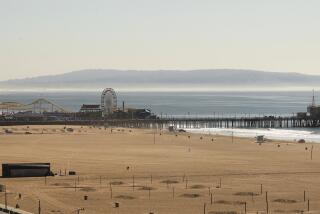The little airport that can
- Share via
Santa Monica is at war with its airport, and it has been for decades. Ever since private jets first rumbled onto the single runway of Santa Monica Municipal Airport — nestled in the neighborhoods of Sunset Park and Ocean Park, bordered by a sliver of Los Angeles — there have been lawsuits, trips to Capitol Hill and frosty showdowns between the Santa Monica City Council and the Federal Aviation Administration, which controls air traffic. On the agenda at various times: noise, pollution, safety.
FOR THE RECORD:
Santa Monica airport: A Jan. 29 editorial said the airport is “nestled in the neighborhoods of Sunset Park and Ocean Park.” It does not abut Ocean Park. —
For those whose only contact with the airport has been a visit to the restaurant Typhoon or the Barneys Warehouse Sale, it’s just a pastoral expanse of land — a plateau dotted with prop planes so small they look like Volkswagens with wings. As a general aviation airport, it handles everything but scheduled airline or military traffic — weekend recreation pilots, fractional share travelers, celebrities and business titans.
But to the neighbors, the closest of whom live just 300 feet from the runway, the airport is a disaster waiting to happen. And what they fear most are the bigger, faster private jets (including some Gulfstreams and Learjets) that land at speeds of 139 to 191 miles per hour. If a plane overshoots the 4,973-foot runway, the city argues, it could crash into houses.
The FAA, for its part, contends that the jets are incredibly safe and are operated by highly trained pilots, and in 20 years at Santa Monica not one has ever crashed or overshot the runway. (Some smaller planes have had some incidents.)
Still, the city voted to ban faster jets in 2007. The FAA balked and got the ban temporarily blocked by a federal court, launching a legal battle with the city. On Jan. 21, an appellate court sided with the FAA, noting that the city had signed an agreement with the agency in 1984 — in exchange for millions in airport improvement funds — guaranteeing that the airport would allow all types of aircraft “without unjust discrimination.”
It’s hard to believe that you can discriminate against corporate jets, but Santa Monica apparently did, and the appellate court said it can’t.
The city now has to decide whether to pursue this further in the courts or to let it drop. But there is another option.
The FAA says its engineering models indicate that even if a fast jet overshot the runway, it wouldn’t reach a house. Still, it has offered to install a barrier of crushable concrete at the west end of the runway. (More than 90% of the air traffic heads west.) The concrete beds are designed to slow a wayward plane. They would, say FAA officials, make a safe airport even safer.
So far city officials and community activists haven’t been buying that as an alternative. For one thing, they are concerned because the offer comes with strings that would extend the city’s obligations to the FAA. (The city contends it will be free to battle the agency for more control of the airport when the 1984 agreement expires in 2015.) For another thing, the city is asking for a second concrete barrier at the east end of the runway, which the FAA won’t install because it would eat up too much of its length and leave it unusable by the fast jets when they are fully fueled. The FAA offered to install two smaller barriers, but the city said that was inadequate. Critics scoff that the FAA is valuing utility over safety.
On this issue, Santa Monicans may be even noisier than the jets flying in and out of the airport, but we say good for them — they have every right to lobby for their safety. But if that’s really what they’re concerned about, then it’s simple: Take the western barrier. It may not be a perfect solution, but it will help increase safety for the vast majority of air traffic. And if the city doesn’t want to be beholden to the FAA? Then it should buy the barrier, which will cost several million dollars. It can hold a fundraiser at the Barker Hangar.
Either would be better than what it has now — which is no safety barrier.
More to Read
A cure for the common opinion
Get thought-provoking perspectives with our weekly newsletter.
You may occasionally receive promotional content from the Los Angeles Times.









